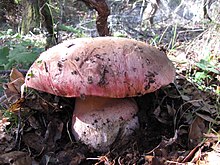Rubroboletus eastwoodiae
| Rubroboletus eastwoodiae | |
|---|---|

| |
| Scientific classification | |
| Domain: | Eukaryota |
| Kingdom: | Fungi |
| Division: | Basidiomycota |
| Class: | Agaricomycetes |
| Order: | Boletales |
| Family: | Boletaceae |
| Genus: | Rubroboletus |
| Species: | R. eastwoodiae
|
| Binomial name | |
| Rubroboletus eastwoodiae (Murrill) Vasquez, Simonini, Svetash., Mikšík, & Vizzini, 2017
| |
| Synonyms[1] | |
| |
| Rubroboletus eastwoodiae | |
|---|---|
| Pores on hymenium | |
| Cap is convex | |
| Hymenium is adnate | |
| Stipe is bare | |
| Spore print is olive-brown | |
| Ecology is mycorrhizal | |
| Edibility is unknown | |
Rubroboletus eastwoodiae, sometimes (but inaccurately) called satan's bolete,[2] is a possibly toxic basidiomycete fungus of the bolete family. It occurs on the West Coast of the United States. It is closely related to Rubroboletus pulcherrimus.
The mushroom turns blue when cut[3] The cap is 10–25 cm wide, convex, olive-colored, pinkish in age, dry, has margin that curves inward then expands, and yellowish flesh.[3] The stalk is 7–15 cm tall and 3–6 cm wide.[3] The spores are olive-brown, elliptical, and smooth.[3] Edibility of this species is unknown, it may be poisonous.[3]
It looks similar to but is genetically distinct from the European species Rubroboletus satanas.[2] It is also similar to Rubroboletus pulcherrimus and Suillellus amygdalinus.[3]
References
[edit]- ^ "Record Details: Rubroboletus eastwoodiae (Murrill) Vasquez, Simonini, Svetash., Mikšík & Vizzini". Species Fungorum. Retrieved 2018-10-27.
- ^ a b Mykoweb.com: Rubroboletus eastwoodiae
- ^ a b c d e f Davis, R. Michael; Sommer, Robert; Menge, John A. (2012). Field Guide to Mushrooms of Western North America. Berkeley: University of California Press. p. 321. ISBN 978-0-520-95360-4. OCLC 797915861.
